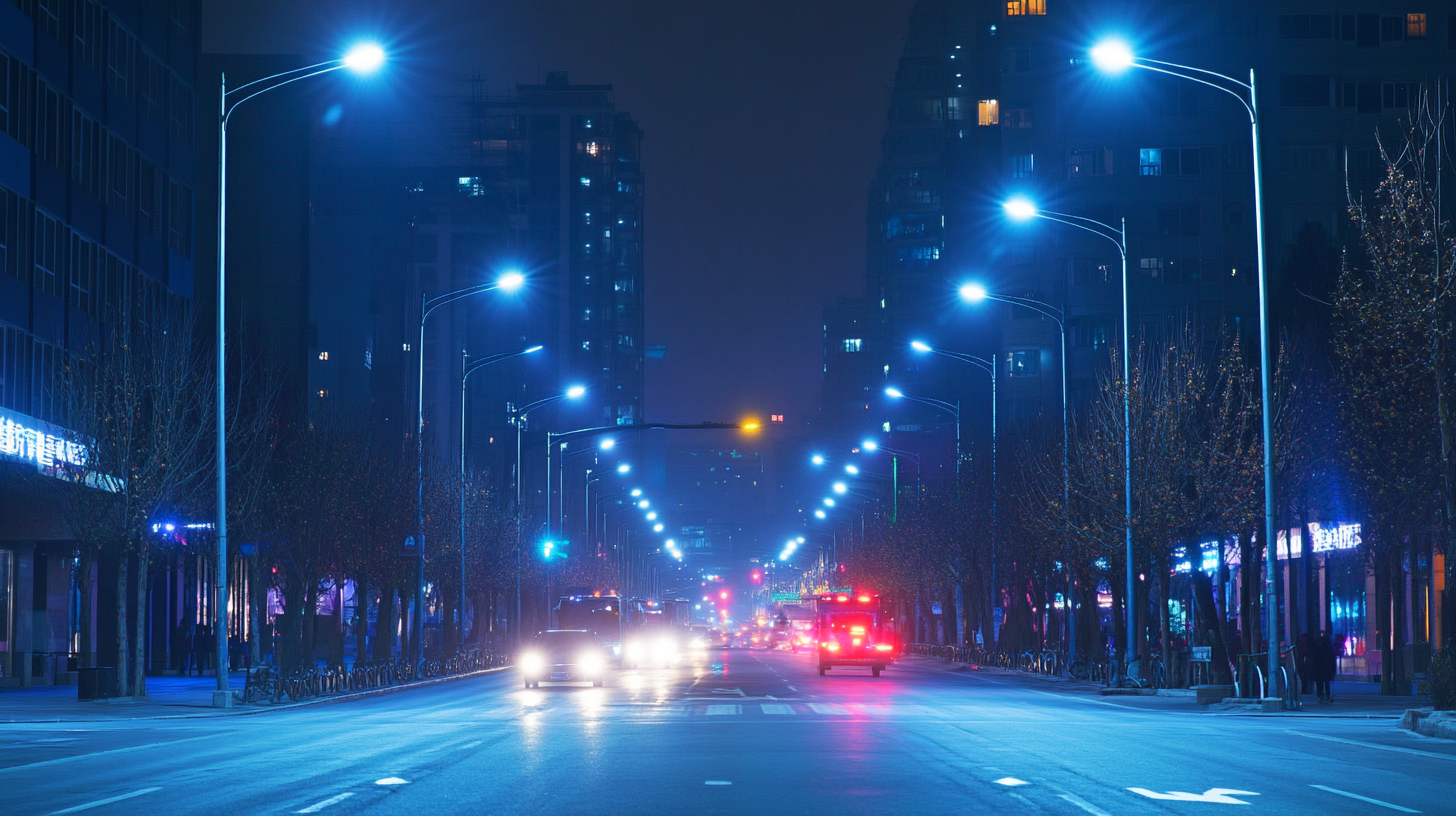Exploring Best LED Street Light Variants Features Applications and How to Choose the Right One
In recent years, the adoption of LED street lights has surged, reflecting the growing need for energy-efficient and sustainable urban lighting solutions. According to a report by the International Energy Agency, outdoor lighting accounts for nearly 40% of the total energy consumption in urban areas, highlighting the urgency for cities to transition to more efficient systems.

LED street lights not only offer significant reductions in energy use—up to 50% less compared to traditional lighting—but also require lower maintenance costs due to their extended lifespan, which can reach over 100,000 hours. Moreover, advanced features such as smart city integration and adaptive lighting capabilities are enhancing their appeal in urban planning.
This blog will explore the various LED street light variants, their features, and applications, while providing insightful tips on how to choose the right one, particularly emphasizing the advantages of after-sales service and overall maintenance costs.
Understanding LED Street Light Variants: Key Differences and Features
When it comes to LED street lighting, understanding the various variants available is crucial for making an informed decision. At the forefront are common types such as cobra head lights, which provide directional lighting ideal for roadways, and post-top fixtures, often used in parks for aesthetic appeal as well as functionality. Key differences in features include lumen output, color temperature, and energy efficiency ratings, which can significantly impact both the effectiveness and operating costs of street lighting systems.
Moreover, the applications of these LED street light variants are diverse. For instance, solar-powered LED lights offer an eco-friendly option for remote areas where traditional electricity supply is unavailable. Smart LED street lights, equipped with sensors and connectivity features, represent an evolution in urban infrastructure, allowing for adaptive lighting that responds to traffic patterns and pedestrian movement. As cities strive toward sustainability and enhanced safety, selecting the right LED street light variant becomes imperative for a successful street lighting strategy.
Essential Applications of LED Street Lights in Urban and Rural Settings
 LED street lights have revolutionized the way we illuminate both urban and rural environments. In urban settings, where traffic and pedestrian safety are paramount, LED street lights offer bright, energy-efficient lighting that enhances visibility during the night. Their ability to provide uniform light distribution reduces shadowy areas, minimizing the risk of accidents. Additionally, these lights can be equipped with smart technology, allowing for automated dimming based on real-time usage, further optimizing energy consumption and operational costs.
LED street lights have revolutionized the way we illuminate both urban and rural environments. In urban settings, where traffic and pedestrian safety are paramount, LED street lights offer bright, energy-efficient lighting that enhances visibility during the night. Their ability to provide uniform light distribution reduces shadowy areas, minimizing the risk of accidents. Additionally, these lights can be equipped with smart technology, allowing for automated dimming based on real-time usage, further optimizing energy consumption and operational costs.
In rural areas, the advantages of LED street lights extend beyond mere illumination. They play a crucial role in promoting safety and accessibility in less densely populated regions. Traditional street lighting often struggles with affordability and maintenance, but LED options provide a more sustainable choice. These lights can be strategically placed to cover long stretches of roads or community spaces, fostering a sense of security and encouraging nighttime activities. Moreover, the implementation of solar-powered LED lights in off-grid areas has enabled even the most remote communities to benefit from reliable lighting solutions, thereby enhancing their quality of life.
Top Features to Look for When Choosing LED Street Lights
When selecting the right LED street lights, several key features should guide your decision-making process. Firstly, consider the lumen output—higher lumens translate to brighter light. According to a report by the U.S. Department of Energy, high-quality LED street lights typically emit between 5,000 to 14,000 lumens, making them efficient for illuminating larger areas while reducing energy consumption. Additionally, color temperature is significant; a range of 4000K to 5000K is ideal for street lighting as it enhances visibility and reduces glare.
Another critical feature is the type of optics used in the LED street lights. Advanced optics ensure uniform light distribution, which minimizes dark spots and increases safety on roadways. Furthermore, the durability of the fixture is paramount. Look for lights with an IP66 rating or higher, which indicates they are resistant to dust and powerful water jets, making them suitable for various weather conditions.
**Tips:** When evaluating street lights, always request a photometric report from the manufacturer; this document provides detailed information about the light distribution, ensuring it meets the specific needs of your project. Also, consider fixtures equipped with smart technology, enabling remote control and monitoring for efficiency and real-time data collection, enhancing the overall safety and functionality of your street lighting system.
Exploring Best LED Street Light Variants Features Applications and How to Choose the Right One - Top Features to Look for When Choosing LED Street Lights
| Variant | Lumens Output | Power Consumption (W) | Color Temperature (K) | Lifespan (hours) | IP Rating | Applications |
|---|---|---|---|---|---|---|
| Standard LED Street Light | 12,000 - 14,000 | 100 | 4000 - 5000 | 50,000 | IP65 | Highways, Urban Areas |
| Smart LED Street Light | 9,000 - 12,000 | 80 | 3000 - 4000 | 100,000 | IP67 | Smart Cities, Parks |
| Solar LED Street Light | 8,000 - 10,000 | 60 | 5000 - 6000 | 25,000 | IP65 | Rural Areas, Pathways |
| Architectural LED Street Light | 10,000 - 12,000 | 75 | 4000 | 70,000 | IP66 | Public Squares, Urban Design |
A Comprehensive Checklist for Selecting the Ideal LED Street Lighting Solution
When it comes to selecting the ideal LED street lighting solution, having a comprehensive checklist can streamline the decision-making process. Start by assessing the wattage required for your area—this will depend on the specific lighting needs of your street, such as traffic volume and pedestrian activity. Next, consider the lumen output, which indicates the brightness of the light. A well-lit street not only enhances safety but also deters crime, making it crucial to choose a variant with an adequate lumen rating.
Another important factor is the color temperature of the LED lights. Typically ranging from warm white to cool white, the color temperature impacts visibility and ambiance. For urban areas, a cooler color temperature is often preferred for its modern appeal, while warmer lights may be ideal for residential zones. Additionally, examine the material and design of the fixtures for durability, especially in regions with harsh weather. Finally, don't overlook energy efficiency—choosing a product with a higher efficacy rating can significantly lower energy costs and contribute to sustainability efforts in your community.

Comparative Analysis of LED Street Lights: Cost-Effectiveness vs. Performance
When considering LED street lights for urban infrastructure, a critical aspect to evaluate is the balance between cost-effectiveness and performance. Cost-effectiveness is often defined by the initial investment required, maintenance expenses, and overall energy savings over the product's lifespan. Many municipalities are tempted to opt for the lowest-priced options; however, this can sometimes lead to subpar illumination quality and increased maintenance costs. A thorough cost-benefit analysis considering long-term savings is essential for making informed decisions.
On the other hand, performance encompasses not just the brightness and efficiency of the lighting, but also factors such as color temperature, durability, and adaptive technology. Higher-performing LED street lights may come at a premium cost, but their superior features can significantly enhance safety and visibility in urban areas. For example, lights with smart technology can adjust brightness based on traffic patterns, further optimizing energy use. Therefore, cities must carefully consider their specific needs and prioritize performance features that will contribute to a sustainable and efficient lighting solution in the long run.
